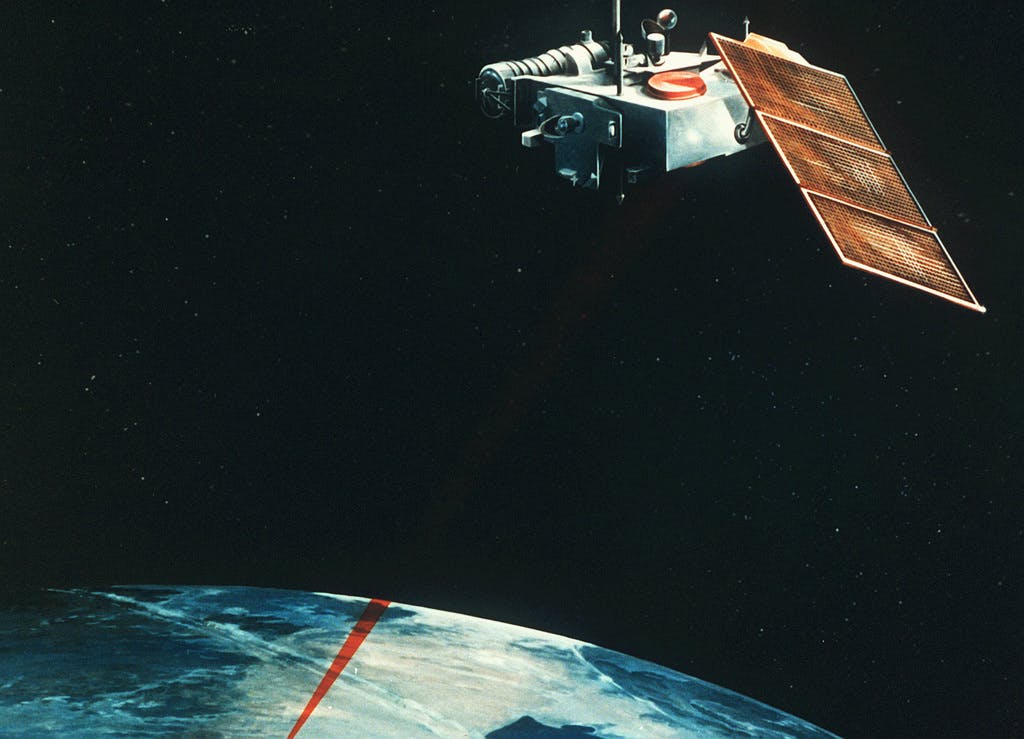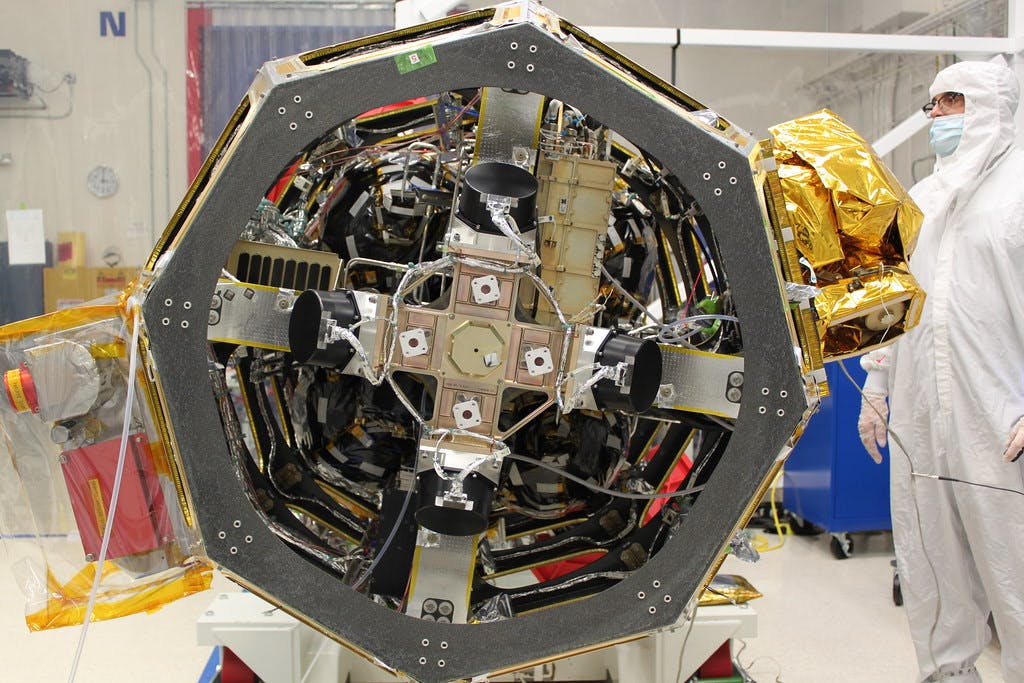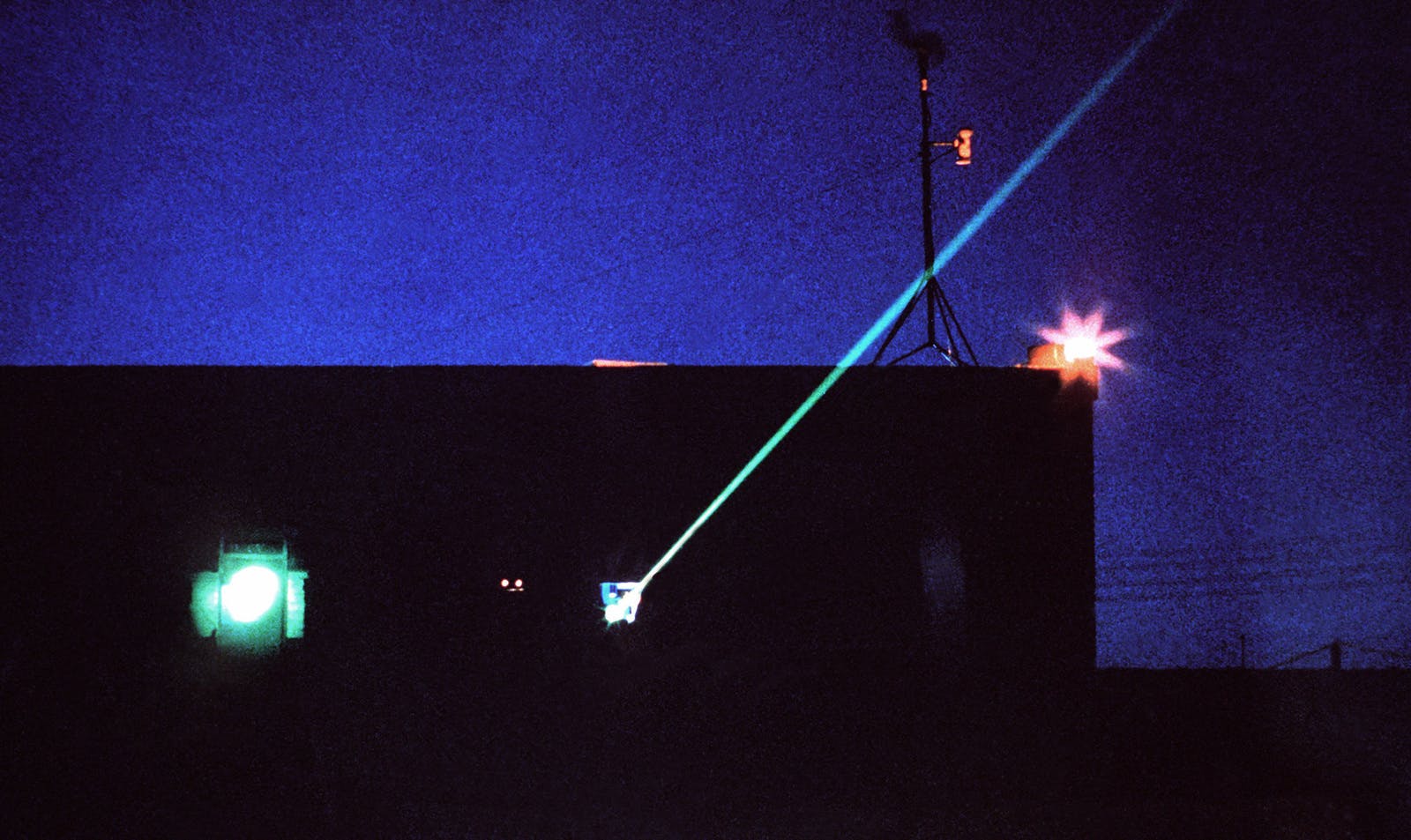An overview of laser optical space communications and key players

Blog
The concept of using frickin’ laser beams to convey communications is not new. The idea of lasers capable of reading stored data was proposed in the 1960s by Theodore Maiman. The first use of a laser optical digital recording was in 1970, and the first commercial pressing of the Compact Disc (CD) occurred in 1982. Totally rad.
However, when it comes to communicating through the air or through space, humanity has been firmly entrenched in the relatively low-frequency, long-wavelength radio frequency (RF) end of the electromagnetic spectrum (EMS) for the past 120ish years. RF-based communications, including radio and broadcast/satellite television, revolutionized long-distance relay of information, but it has its limitations in space (as well as in ground- and satellite-based telecoms).
Well, a new generation of outside-of-the-box thinkers is developing communications systems using non-visible infrared radiation (IR) lasers to transmit information, and it looks like it has the potential to completely change how people communicate over long distances, whether on Earth, in space, or even between planets.
In December 2021, NASA launched the Laser Communications Relay Demonstration (LCRD) into space. The LCRD is NASA’s first laser-based space communication system, and has the objective of testing optical communications in space, with the potential for acting as a relay for IR comms between Earth and missions to space or other planets.
But commercial firms including SpaceX, Sony Space Communications, Myarnic, Northrop Grumman, and others are looking to capitalize on the commercial and/or military demand and potential for greater bandwidth, smaller satellites, lighter payloads, and reduced power requirements that IR laser-based comms systems can provide closer to home.
Let’s go over the primary advantages (and some disadvantages) of laser optical space communications, and then we’ll fill you in on some of the key players in this burgeoning industry.

Advantages of laser optical space communications
The primary advantage of IR laser optical space communications compared to traditional RF signals is a huge increase in potential bandwidth, or the amount of data that can be relayed over a specified period of time. For example, in the United States, satellite radio operates on the 2.3 gigahertz (GHz) S band of the electromagnetic spectrum. The S band encompasses a frequency between 2-4 GHz and a wavelength between 15 and 7.5 centimeters. TV signals (which are classified as radio waves) have wavelengths between about 50 centimeters up to 10 meters.
In the Infrared (IR) portion of the electromagnetic spectrum, on the other hand, frequencies range from about 300 gigahertz (GHz) up to about 400 terahertz (THz), and wavelengths are estimated to range between 1,000 micrometers (approximately. 0.0393 inches) and 760 nanometers (2.99e-5 inches, or about 7.6e-5 centimeters), although these values are not definitive according to NASA.
Via Satellite explains, “the higher the frequency (and the shorter the wavelength), the more data is encodable in the waveform. From S-band through C-band, to X-band and K-band, radio frequency, or RF, satellite communications have evolved from low frequency dial-up speeds to today’s multi-gigabit per second very high throughput satellites using wavelengths under one centimeter. But the highest frequencies of all in the electromagnetic spectrum are in the visible light end of the spectrum, up to 10,000 times higher than even the highest frequency Ka-band RF.”
The upshot of all of this is that optical laser communications systems have potential effective bandwidth increases of 10 to 100 times compared to today’s RF systems. NASA says, “The addition of laser communications to spacecraft is similar to switching from dial-up to high-speed internet.”
An additional benefit of using IR lasers to send and receive data is that using systems such as NASA’s LCRD, scientists no longer need direct line of sight to target satellites, space stations, or outposts with IR beams. Earth-based signals can be “bounced off” or relayed from the LCRD to the target, and vice versa.
And finally, when it comes to traditional RF communications systems relying on satellites in low Earth orbit (LEO), there is the practical issue of the size and number of satellites crowding the LEO space, and the limited permissible use of the RF spectrum for comms. This is partially due to practical power needs and the required size of satellite RF antennas. Conventional radio communications need larger satellite antennas and more power (and, accordingly, more heat – hint, hint) than optical networks, Sony said, making it “physically difficult” to achieve high speeds on small satellites when using RF.
The volume of data used in LEO is increasing every year but the amount of radio waves is limited, according to a statement by Sony Space Communications president Kyohei Iwamoto. “Additionally, the need for frequency licenses for radio waves and the requirement for lower power consumption of communication equipment needed by smaller satellites, like micro satellites, are also issues to be addressed.”
Fortunately, NASA says, “optical communications provides decreased size, weight, and power requirements. A smaller size means more room for science instruments. Less weight means a less expensive launch. Less power means less drain on the spacecraft’s batteries. With optical communications supplementing radio, missions will have unparalleled communications capabilities.”
This also applies to communications satellites in LEO, which can now be much smaller and lighter than traditional RF-based satellites. Sony said it has been researching and developing optical communications systems that are small enough to fit microsatellites, which NASA defines as spacecraft between 10 and 100 kilograms. NASA’s TeraByte InfraRed Delivery (TBIRD) system is the size of a tissue box, and is capable of relaying terabytes of data in a single 7-minute pass.

Disadvantages or challenges of laser optical space communications
Optical communications has serious advantages in bandwidth, size, weight, and more, but the industry faces several challenges. The first has to do with precision. NASA points out, “Unlike radio communications, which can be sent out in a broad beam blanketing target areas with its signal, optical communications is sent in a relatively narrow beam pointed directly at a receiver. When broadcasting from thousands or millions of miles away, an optical communications telescope pointing must be extremely precise. A deviation of even a fraction of a degree can result in the laser missing its target entirely.”
(Companies like iXblue have developed highly accurate gyroscopes for use on spacecraft and comms satellites to help keep them aimed perfectly. Additionally, Fast Company points out one inherent advantage to this necessary precision: “Lasers can be aimed precisely at a receiver, while radio broadcasts indiscriminately, making eavesdropping a much bigger risk.”)
In addition, just like Earth-based lasers, the beam of space-based optical lasers spreads out slightly, or becomes dispersed over distance as well as due to any interference in the way. As this occurs, the beam becomes less coherent and the data is harder to retrieve. NASA is developing special receivers called photon-counting detectors that are able to detect single photons as they travel in the optical beam from space to earth. This can help with laser-based space navigation but may not solve the issue entirely for comms, depending on the distance.
A more immediate concern for companies wanting to play in the terrestrial optical comms market is that Earth’s atmosphere interferes with optical communications. Clouds, mist, smog, and smoke can interrupt a laser. One solution to this that NASA is considering is building multiple ground stations, basically telescopes, that receive infrared waves and can relay or redirect them. So if there’s cloud cover over one station, the beam can be redirected to a different station. With more ground stations, the network can be more flexible during bad weather.
If satellites get sophisticated enough that companies can move them around at will, this might help with both the overcrowding of the LEO space, as well as possibly solving optical comms problems due to clouds, smoke, or other terrestrial interference.
Let’s go over a few of the pioneers in this space who are working to address these challenges.

SpaceX
SpaceX has long been a pioneer in commercial space launches and NASA has even relied on Elon Musk’s company for several space deliveries, including the upcoming Starship moon landing. SpaceX’s Starlink satellite “constellation,” providing a “low-latency” broadband internet service, has earned a good market share up to now, and was originally built to run in the RF spectrum, although, starting September 2021, they have been laser-link capable (but not activated).
However, on June 10, 2022, Musk tweeted that “Starlink inter-satellite laser links should be operational by end of year.” If Starlink gets full FCC clearance for laser-optical comm links, the satellites will then be able to relay the internet signal much faster, since they won’t have to rely on the base stations to feed the radio signals from the ground. This should vastly improve signal latency, as light travels a lot faster in a vacuum than even in fiber optic cables. Musk tweeted, “Light travels ~40% faster in vacuum/air than in fiber optic cables & satellite path length is shorter (cables follow coastlines).”
Musk is an unabashed proponent of his innovations and tech, but if he can get this laser comms satellite system working up to its potential it could be a real gamechanger… and not just for video gamers aiming to pew pew each other on the Starlink network.
Myarnic
Myarnic, with offices in Germany and California, aims to welcome the world to what it terms “the industrial age of laser communication.” The company is developing laser comms systems for space, aviation, and ground-based applications.
Myarnic emphasizes that interconnecting multiple satellite and ground networks via laser is going to be vital as the market progresses. Fast company quotes Tina Ghataore, chief commercial officer at Mynaric: “Creating that ubiquitous mesh network connectivity is becoming more and more important right now.”
One interesting selling point Myarnic is touting is that “laser communication is a license-free technology.” As we’ve seen with SpaceX, the US FCC requires permits to use existing RF-transmitting satellites to link via lasers. Myarnic’s site says, “Before you even start thinking about launching your [traditional RF-based] satellite you need to apply for a license from every country you want to send an RF beam down to. You have to pay the costs associated with each licensing regime. Then you have to wait. And wait. And then, in about a year, you might – just – be ready to launch your satellite and start your broadband service. Laser communication is not regulated by the International Telecommunication Union and it can be used without restrictions and does not require costly licenses. The reason for this is that its inherent small beam size avoids interference issues and renders any restrictive regulation in the future highly unlikely.”
We’ll see if that prediction holds as the world becomes more dependent on optical comms. Keep your fingers crossed!
Sony Space Communications
As we mentioned briefly above, Sony has started its Space Communications division, as of June 1, 2022. Per Sony, “SSC plans to develop small optical communications devices to provide related services to connect micro satellites in LEO via a laser beam. SSC plans to offer this optical communications equipment as a service to companies working on satellite development. By using optical communications, SSC aims to realize high-speed communications with small devices, which are physically difficult to achieve with conventional radio communications because conventional communications require large antenna (sic) and high power output. In addition, by constructing an optical communications network not only between satellites and the ground, but also between satellites in orbit, SSC aims to enable real-time communications from anywhere on the ground to any satellite in space.”
You may know that Sony and Philips went back-and-forth for initial dominance and innovation in the CD/laser data field, and Sony aims to cash in on that knowledge and technology. “By applying the optical disc technology that Sony Group has cultivated over many years in the development and production of CD players and other products, it aims to realize optical communications devices that are ultra-compact, lightweight, mass producible, and can withstand harsh environments such as space.”
Since accurately tracking and aiming a laser over long distances will likely require similar technology to reading a moving, spinning, and even warped CD or DVD with a laser, we’re betting Sony will be among the frontrunners in this aspect of the new tech.
BridgeComm
BridgeComm is a Denver-based firm developing airborne, space, and terrestrial optical comms. BridgeComm says they have “developed the proprietary Managed Optical Communication Array (MOCA) hardware and software technology. MOCA technology allows for multi-domain capabilities to share large volumes of data and collaborate significantly faster with increased security. BridgeComm’s MOCA technology enables a point-to-multipoint (PtMP) laser communications solution with a rapid non-mechanical steerable system that achieves multi-target transmit and receive connections, while significantly reducing the size, weight, and power of traditional tracking OWC [optical wireless communications] terminals. The technology is modular and scalable, allowing for rapid development and implementation of terminals suitable for space, air, land, and sea domains.”
BridgeComm's former CEO Barry Matsumori (current CEO is Michael Abad-Santos) pointed out that traditional radio-frequency links can’t keep up with the speeds and bandwidth offered by the new optical comms systems. Per Fast Company: “We routinely do 100 gigabits per second . . . . We’re heading toward being able to do a terabit.” Matsumori continued, “If you really really need speed, like more than 10 gigs per second, RF starts falling apart,” and added that we’re running out of frequencies to free up for broadband use: “[The] RF spectrum, the usable part, is basically all allocated.”
Hopefully companies like BridgeComm can help humanity overcome that RF bottleneck.
Northrop Grumman
Northrop Grumman has lots of experience with laser comms and even directed energy weapons, and is developing tech to solve (among other things) what it calls the “last mile problem” for urban communications systems. “Digging trenches to lay fiber is expensive, especially in urban areas. A pair of high bandwidth FSO [free-space optical communications] terminals can be deployed faster and cheaper than fiber of equivalent bandwidth. Compared to other wireless technology, FSO is more secure due to the difficulty of clandestine interception of a narrow laser beam of an [adaptive optical] system.”
One of the important innovations Northrop has developed is a way to potentially solve or mitigate the problem of “speckling” or fading of the laser beam due to atmospheric or other interference near the ground. The company says, “We have built custom wavefront sensors to gather data from field measurements of turbulence over horizontal line of sight paths. The results have shown feasibility of achieving a degree of correction using successive modal corrections from the atmospheric turbulence.”
In essence, this new sensor and correction technology has the potential to reduce or eliminate signal fading due to atmospheric conditions, which is one of the primary stumbling blocks of the new laser-based optical comms systems.
If anyone can figure it out, these folks can!
–By Jeff Davis, Intergalactic Scribe
Sources:
https://www.laserchirp.com/2016/05/throwback-thursday-lasers-and-the-development-of-the-cd-player/
https://www.nasa.gov/mission_pages/tdm/lcrd/index.html
https://www.britannica.com/technology/satellite-radio
https://www.livescience.com/50260-infrared-radiation.html
https://www.nasa.gov/directorates/heo/scan/opticalcommunications/challenges
https://spacenews.com/sony-launches-space-laser-communications-business/